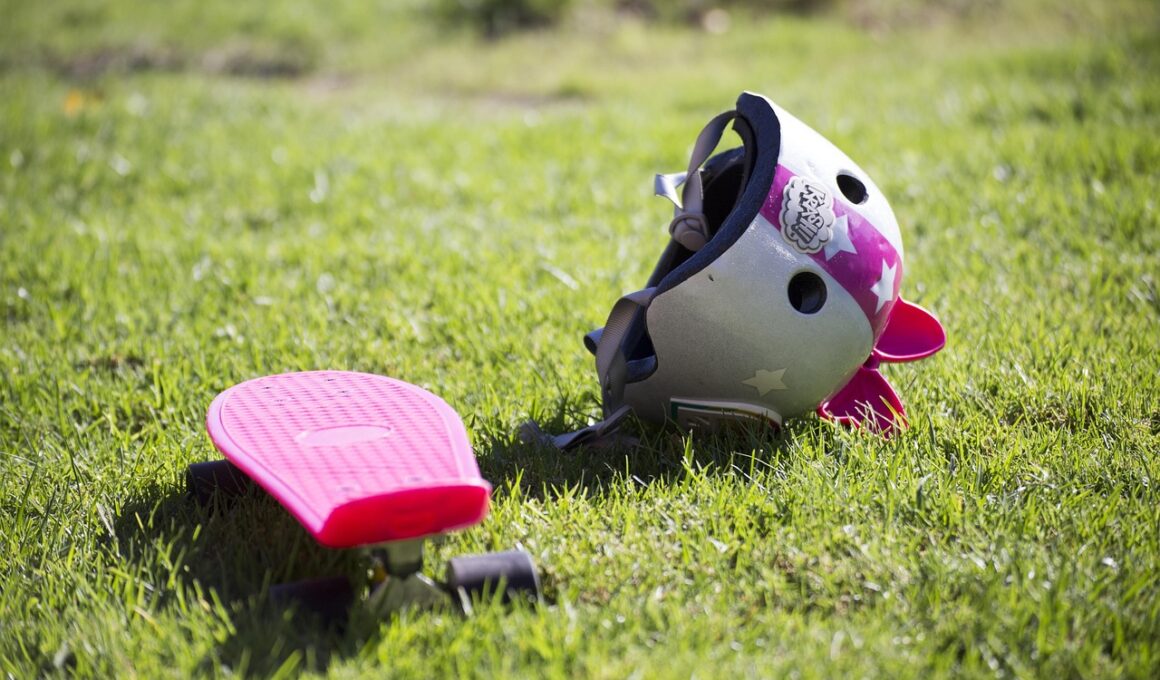The Importance of Wearing a Helmet While Skateboarding
Skateboarding is an exhilarating activity that attracts enthusiasts of all ages. However, safety should always be the main priority for anyone who engages in this fun sport. One of the most critical aspects of skateboard safety is the usage of a helmet. Helmets are specifically designed to protect your head during falls or impacts, significantly reducing the risk of severe injuries. By wearing a helmet, skateboarders can safeguard themselves against concussions and other serious brain injuries, which can have life-altering consequences. The right helmet not only provides protection but also fits your head comfortably. Ensuring a proper fit is crucial for effective safety. Additionally, many skate parks and communities mandate helmet use due to their vital role in preventing head injuries. This requirement emphasizes the culture of safety surrounding skateboarding. Many new skateboarders, especially children, need to understand that wearing a helmet is not just a recommendation; it’s an essential part of their gear. When you choose to wear a helmet, you model responsible behavior for younger skaters, promoting a safer skating environment for everyone.
As skateboarders become more aware of safety, many manufacturers are investing in better helmet designs. These designs prioritize both protection and comfort, ensuring that skaters can wear them for extended periods without issue. Helmets now come in various styles, colors, and sizes, allowing skaters to express themselves while prioritizing safety. The materials used in modern helmets are engineered to absorb impact effectively, making them much more reliable than those used in the past. Additional features like moisture-wicking liners and adjustable straps further enhance the overall experience. By selecting well-reviewed helmets, skateboarders can feel confident in their safety. It’s essential to remember that a helmet is only effective if worn correctly. To maximize protection, skaters should consistently buckle their helmet securely before every ride. Education is key in cultivating a culture of safety in the skateboarding community. Skate parks are increasingly providing educational resources and workshops to teach proper helmet usage and other safety tips. Engaging in conversations about helmet use can change perceptions, making safety an integral part of skateboard culture. The more skateboarders talk about helmets, the more they build a community grounded in responsibility.
Understanding Common Injuries in Skateboarding
Many beginner skateboarders remain unaware of the potential injuries associated with the sport, making helmet use even more vital. Common injuries among skateboarders often include bruises, fractures, and head injuries due to falls. These falls frequently occur while learners practice new tricks, emphasizing the need for protective gear. While most skateboarders experience minor injuries, significant head injuries can lead to long-term consequences. Wearing a helmet reduces the chances of sustaining severe injuries in the event of a fall, offering vital protection. Statistics reveal that skaters who do not use helmets are at a higher risk of life-threatening injuries compared to those who do wear them. Organizations, including skateboarding schools, encourage helmet use, hoping to minimize accidents. Encouraging a culture of safety will also help skateboarders make informed decisions. In addition, adopting other protective gear, such as knee and elbow pads, can create an overall safer skating experience. Education, combined with advocacy for helmet use, is crucial in promoting safety. Using educative materials and workshops can help increase awareness, and communities must work together to create a safer atmosphere for all skaters.
To further stress helmet importance, studies illustrate a direct link between helmet use and reduced injury severity. Those who wear helmets frequently report fewer instances of concussions and other significant injuries among skaters. Many advocates argue that helmet laws and enforcement will lead to broader changes in safety culture. Furthermore, making helmet requirements commonplace will transform skateboarding perceptions, encouraging responsible practices in skate parks. The obvious risk of head injuries, combined with the knowledge that helmets are accessible and effective, should motivate skateboarders to prioritize wearing them consistently. There are numerous resources available on proper helmet use, including online tutorials and workshops at local skate parks. An engaged skating community, focusing on safety, can positively impact attitudes toward helmet use. Simple conversations can enlighten fellow skateboarders about the advantages of wearing head protection. It is vital to lead by example and educate others on combating the misconception that not wearing a helmet is acceptable. Creating discussions on social media platforms can further strengthen the community’s commitment to promoting helmet use, resulting in a significantly safer environment for both new and experienced skateboarders on their thrilling adventures.
Choosing the Right Helmet for Skateboarding
Selecting the right helmet is a crucial step for any serious skateboarder. With so many options available, understanding the different types of helmets can help you make informed decisions. For instance, skate-specific helmets usually feature attributes that cater directly to the demands of skateboarding, such as hard outer shells and shock-absorbing inner liners, which enhance protection. You should also prioritize adjustable, comfortable sizes to ensure a perfect fit. It’s also wise to consider the certifications or standards that a particular helmet meets, which can often be found on the label. More importantly, ensure that the chosen helmet provides adequate ventilation to keep cool during sessions. Styles and designs should also resonate with the skater’s identity since personalization helps increase the likelihood of consistent use. Popular brands have embraced custom designs, leading to helmets that appeal visually and effectively protect. Additionally, wearing a helmet that matches personal style could encourage fellow skaters to adopt similar safety practices. Remember to check safety standards when purchasing from online marketplaces, and involve community feedback to ensure informed selections. When skaters prioritize proper gear, it transforms the overall safety landscape.
After selecting an appropriate helmet, schooled skateboarders will appreciate that wearing it is only one aspect of promoting safety. Responsible skating practices can significantly reduce the chance of accidents occurring. Therefore, it is essential for skaters to be aware of their surroundings while skating, avoiding congested areas and obstacles. Keeping a safe distance from pedestrians also helps in solidifying the community’s positive reputation. Additionally, wearing bright or reflective clothing can improve visibility and potentially prevent accidents. Engaging in skateboarding with friends can also create a safety net, allowing skaters to watch out for each other. Group skating makes it easier to communicate potential dangers on the ground and encourages collaborative safety efforts. Furthermore, understanding how the terrain works, including skate park designs, will enhance overall skateboarding experience. Skaters should also practice skills progressively, gradually taking on more challenging tricks instead of rushing into complex maneuvers they may not yet master. By fostering a culture that emphasizes gradual teaching and encouragement, skateboarders can create an environment where risk-taking doesn’t come at the expense of safety. Remember that consistent helmet wear and practicing safe skating contribute significantly to a positive skate culture.
Conclusion: Make Safety a Priority
In conclusion, the importance of wearing a helmet while skateboarding cannot be understated. Helmets play an integral role in protecting skateboarders from head injuries, allowing for more enjoyable and safer rides. By prioritizing protective gear, skaters encourage others to follow suit, fostering an atmosphere of responsibility. Statistics validate the effectiveness of helmets in reducing injuries, reinforcing that they are necessary. Sports organizations, coaches, and seasoned skaters should continue to advocate for helmet use through education and community outreach. As the skateboarding community evolves, it is essential to keep safety at the forefront. Creating initiatives emphasizing helmet use, educating through workshops, and enforcing policies can enhance the culture surrounding skateboarding. Skateboarders need to recognize that protecting themselves also protects fellow skaters. As individuals, we hold the power to influence others in our community. By sharing experiences, resources, and perspectives regarding skateboard safety, we all contribute to a safer environment. Skateboarding should remain a thrilling and enjoyable pursuit. Wearing a helmet is one such step to ensure that thrill, accompanied by a greater sense of security. Ultimately, let’s prioritize safety by wearing helmets!
Skateboarding is a thrilling activity loved by many, but safety is paramount. Wearing a helmet is one of the most important safety measures for skateboarders. Helmets can significantly reduce the risk of head injuries and concussions that can occur during falls or accidents. Many beginners might underestimate the significance of helmet protection, leading to devastating consequences. The right helmet not only protects the head but also provides comfort. It is essential to ensure a proper fit for maximum effectiveness. Additionally, many skate parks enforce helmet rules to create a safer environment for all. This reinforces the culture of safety within the skateboarding community. Those who wear helmets tend to be more responsible and encourage peers to do the same. The type of helmet also matters, with options varying from classic skate designs to modern variations that enhance safety while look appealing. Educating new skaters about the benefits of wearing helmets can foster a strong safety culture. Moreover, talking to experienced skateboarders helps young or beginner skaters understand the importance of helmets, ensuring that respect for safety remains a priority. Creating a supportive environment emphasizes safety and leads to better skating experiences overall.


